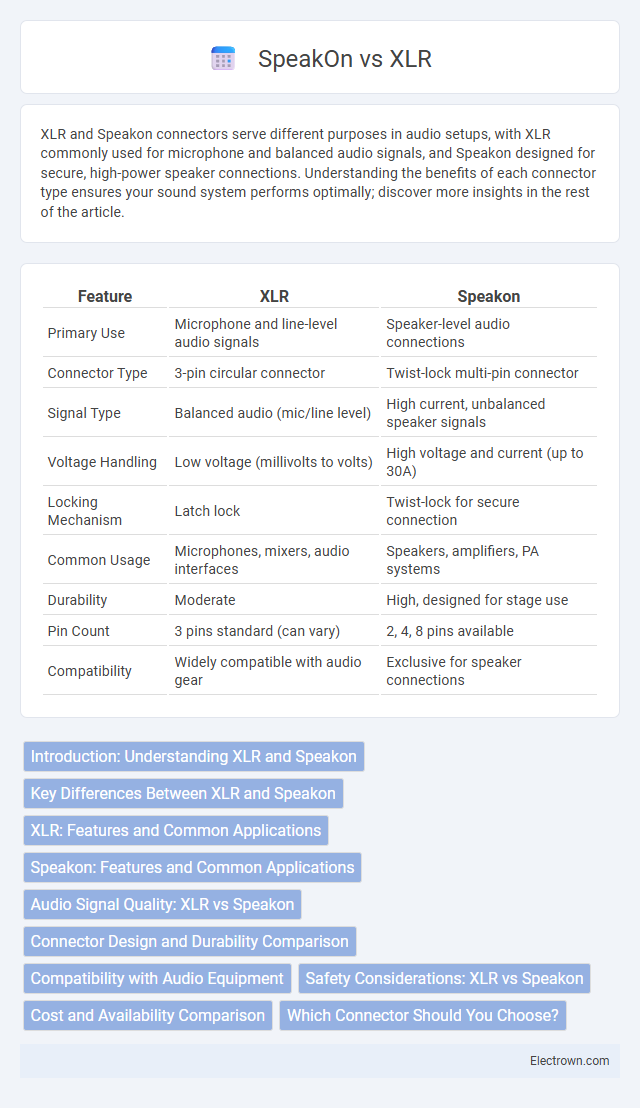XLR and Speakon connectors serve different purposes in audio setups, with XLR commonly used for microphone and balanced audio signals, and Speakon designed for secure, high-power speaker connections. Understanding the benefits of each connector type ensures your sound system performs optimally; discover more insights in the rest of the article.
Table of Comparison
| Feature | XLR | Speakon |
|---|---|---|
| Primary Use | Microphone and line-level audio signals | Speaker-level audio connections |
| Connector Type | 3-pin circular connector | Twist-lock multi-pin connector |
| Signal Type | Balanced audio (mic/line level) | High current, unbalanced speaker signals |
| Voltage Handling | Low voltage (millivolts to volts) | High voltage and current (up to 30A) |
| Locking Mechanism | Latch lock | Twist-lock for secure connection |
| Common Usage | Microphones, mixers, audio interfaces | Speakers, amplifiers, PA systems |
| Durability | Moderate | High, designed for stage use |
| Pin Count | 3 pins standard (can vary) | 2, 4, 8 pins available |
| Compatibility | Widely compatible with audio gear | Exclusive for speaker connections |
Introduction: Understanding XLR and Speakon
XLR connectors are widely used for balanced audio signals in microphones and professional audio equipment, offering secure, low-noise connections with three pins for ground, positive, and negative signals. Speakon connectors are designed specifically for connecting amplifiers to loudspeakers, featuring twist-lock mechanisms and robust construction to handle higher current and ensure reliable, noise-free power transmission. Understanding the distinct applications and technical advantages of XLR and Speakon connectors is crucial for optimizing audio system performance.
Key Differences Between XLR and Speakon
XLR connectors primarily transmit low-level audio signals and are widely used in microphones and balanced audio equipment, offering 3-pin configurations for balanced connections. Speakon connectors are designed for high-power speaker connections, providing secure, lock-in cable connections with multi-pole options, commonly supporting 2, 4, or 8 conductors. Key differences include XLR's focus on signal transmission with balanced audio integrity versus Speakon's emphasis on high-current capacity and mechanical locking for professional speaker systems.
XLR: Features and Common Applications
XLR connectors feature a durable, three-pin design that ensures balanced audio signals, minimizing noise and interference, making them ideal for professional microphone and audio equipment connections. Commonly used in live sound, recording studios, and broadcast environments, XLR cables support low impedance signals for high-quality audio transmission. Your setup benefits from XLR's secure locking mechanism and widespread compatibility with mixers, preamps, and audio interfaces.
Speakon: Features and Common Applications
Speakon connectors are designed for high-power audio signals, offering secure locking mechanisms that prevent accidental disconnection during live performances or studio sessions. Commonly used in professional speaker and amplifier connections, Speakon cables handle higher current loads with minimal signal loss, making them ideal for PA systems and stage setups. Your audio system benefits from Speakon's durability and reliable contact points, ensuring consistent sound quality in demanding environments.
Audio Signal Quality: XLR vs Speakon
XLR connectors provide balanced audio signals ideal for microphones and high-fidelity audio equipment, minimizing noise and interference over long cable runs. Speakon connectors are designed for high-current speaker-level signals, offering secure, locking connections but are less suited for delicate low-level audio signals. For optimal audio signal quality in professional sound setups, XLR is preferred for line and mic-level signals, whereas Speakon excels in delivering robust power to loudspeakers.
Connector Design and Durability Comparison
XLR connectors feature a compact, three-pin design ideal for balanced audio signals, ensuring secure connections with a locking mechanism, while Speakon connectors boast a robust, twist-lock design that supports higher current handling and multiple conductor configurations for speaker cables. Speakon connectors are generally more durable due to their rugged construction and resistance to accidental disconnection, making them preferable in professional audio environments where reliability is critical. Choosing the right connector depends on your specific application, with Speakon favored for speaker-level connections and XLR for microphone and line-level audio signals.
Compatibility with Audio Equipment
XLR connectors are widely compatible with a broad range of audio equipment, including microphones, mixers, and recording interfaces, due to their standardized design and three-pin configuration. SpeakON connectors are primarily designed for connecting professional loudspeakers and amplifiers, offering locking mechanisms that ensure secure, high-current connections suitable for PA systems and stage monitors. While XLR is favored for low-level balanced audio signals, SpeakON excels in handling high-power speaker-level signals, making them each optimized for specific segments of audio equipment compatibility.
Safety Considerations: XLR vs Speakon
XLR connectors, while commonly used for audio signals, lack the secure locking mechanism found in Speakon connectors, increasing the risk of accidental disconnection and potential signal loss during performances. Speakon connectors are specifically designed for high-power speaker connections, featuring locking latches that ensure a firm, reliable connection and prevent exposure to live contacts, significantly enhancing user safety. The insulated contacts and robust construction of Speakon cables reduce the hazards of electrical shorts or shocks, making them the preferred choice for professional sound reinforcement systems where both safety and durability are critical.
Cost and Availability Comparison
XLR connectors typically offer lower costs and broader availability due to their widespread use in audio equipment, making them a budget-friendly choice for many users. SpeakON connectors, designed for professional-grade speaker connections, tend to be more expensive but provide superior secure locking and durability. Choosing between XLR and SpeakON ultimately depends on your specific audio setup needs and budget constraints.
Which Connector Should You Choose?
Choosing between XLR and SpeakON connectors depends on the application and equipment compatibility; XLR connectors are widely used for balanced audio signals and microphone connections, offering versatility in stage and studio setups. SpeakON connectors are specifically designed for loudspeaker connections, providing secure locking mechanisms and high current capacity, making them ideal for professional PA systems and amplifier-to-speaker connections. Selecting the correct connector ensures optimal signal integrity, safety, and reliability in audio signal transmission.
xlr vs speakon Infographic

 electrown.com
electrown.com